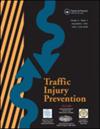Development of hazard prediction test and interventions for two-wheeled electric vehicle riders in China
IF 1.6
3区 工程技术
Q3 PUBLIC, ENVIRONMENTAL & OCCUPATIONAL HEALTH
引用次数: 0
Abstract
Objective
This paper aimed to develop a hazard prediction test and enhance two-wheeled electric vehicle (TWEV) riders’ hazard perception and prediction capabilities via interventions by executing two distinct studies. Study 1 aimed to develop and validate a hazard prediction test. Study 2 evaluated the efficacy of two interventions, self-commentary and what happens next (WHN), integrating expert commentary.
Method
For Study 1, a video-based hazard prediction test was developed through video recording and clipping, with participants categorized into high and low prediction ability groups for experimentation. Data analysis employed the receiver operating characteristic (ROC) curve. Study 2 categorized participants into four groups: self-commentary with licenses (SCL), self-commentary without licenses (SCNL), WHN with licenses (WHNL), and WHN without licenses (WHNNL), for conducting a one-week intervention experiment. Data collected from participants’ pre-intervention, post-intervention, and aftereffect tests were subjected to repeated measures analysis of variance (ANOVA).
Results
Analysis of the ROC curve indicated the test can distinguish the riders with different hazard prediction levels. ANOVA results demonstrated that the measurement time had a significant positive effect on scores (p < 0.001). Both interventions significantly improved hazard prediction ability (p < 0.05), and the effect persisted one week after administration. The effect of the WHN intervention was significantly greater than the self-commentary method across all time points.
Conclusion
The hazard prediction test developed in this study could assess riders’ hazard prediction ability, with the identified interventions demonstrating effectiveness in enhancing this ability. These findings suggested potential application in future qualification tests for TWEV riders, contributing to enhanced traffic safety awareness among TWEV riders in China, thus advancing overall traffic safety.
中国两轮电动车驾驶员危险预测测试和干预措施的开发。
目的:本文旨在通过两项不同的研究,开发一种危险预测测试,并通过干预措施提高两轮电动车(TWEV)骑行者的危险感知和预测能力。研究1旨在开发和验证危险预测测试。研究 2 评估了自我评论和下一步会发生什么(WHN)这两种干预措施的效果,并结合了专家评论:研究 1 通过视频录制和剪辑开发了基于视频的危险预测测试,并将参与者分为预测能力高和预测能力低两组进行实验。数据分析采用接收者操作特征曲线(ROC)。研究 2 将参与者分为四组:有许可证的自我评论组(SCL)、无许可证的自我评论组(SCNL)、有许可证的 WHN 组(WHNL)和无许可证的 WHN 组(WHNNL),进行为期一周的干预实验。对参与者的干预前、干预后和后效测试数据进行重复测量方差分析(ANOVA):结果:ROC 曲线分析表明,该测试可以区分不同危险预测水平的骑行者。方差分析结果表明,测量时间对得分有显著的正向影响(p p 结论:本研究开发的危险预测测试可区分不同危险预测水平的骑手:本研究中开发的危险预测测试可评估骑手的危险预测能力,所确定的干预措施在提高这一能力方面具有有效性。这些研究结果有望应用于未来的双轮电动车驾驶员资格测试,有助于提高中国双轮电动车驾驶员的交通安全意识,从而促进整体交通安全。
本文章由计算机程序翻译,如有差异,请以英文原文为准。
求助全文
约1分钟内获得全文
求助全文
来源期刊

Traffic Injury Prevention
PUBLIC, ENVIRONMENTAL & OCCUPATIONAL HEALTH-
CiteScore
3.60
自引率
10.00%
发文量
137
审稿时长
3 months
期刊介绍:
The purpose of Traffic Injury Prevention is to bridge the disciplines of medicine, engineering, public health and traffic safety in order to foster the science of traffic injury prevention. The archival journal focuses on research, interventions and evaluations within the areas of traffic safety, crash causation, injury prevention and treatment.
General topics within the journal''s scope are driver behavior, road infrastructure, emerging crash avoidance technologies, crash and injury epidemiology, alcohol and drugs, impact injury biomechanics, vehicle crashworthiness, occupant restraints, pedestrian safety, evaluation of interventions, economic consequences and emergency and clinical care with specific application to traffic injury prevention. The journal includes full length papers, review articles, case studies, brief technical notes and commentaries.
 求助内容:
求助内容: 应助结果提醒方式:
应助结果提醒方式:


